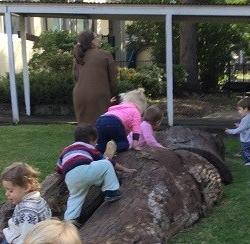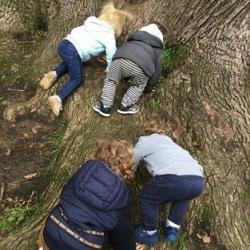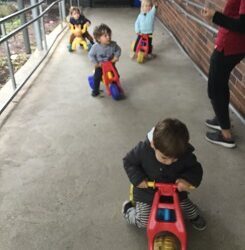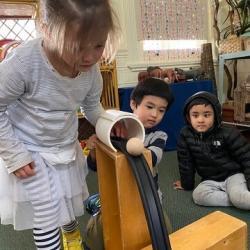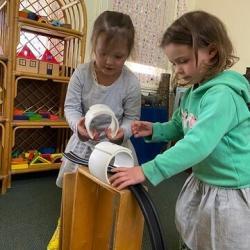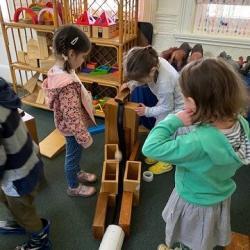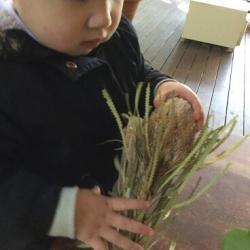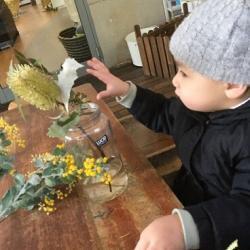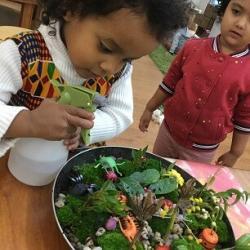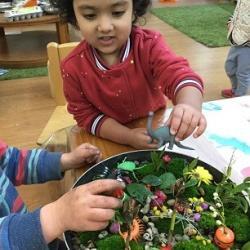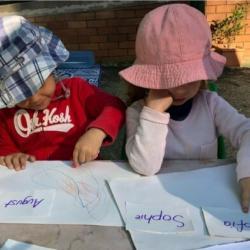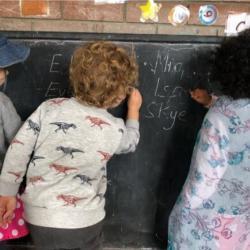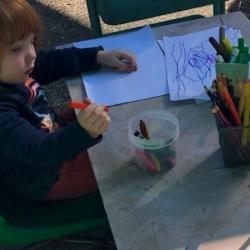Gorton House
Every Friday, Gorton House infants’ room educator Leila takes a group of children for a nature walk and a bike ride. This has become a routine for the children, and every Friday the children now ask Leila “Bike ride?”, “Walking?”
Last week the children went a for bike ride, visited the fish in reception, climbed on the tree next door to reception and discovered some of the many natural resources around them.
When bike riding the children really enjoy going up and down the ramp, racing with their friends, and then the nearby climbing tree. This has been great in helping to develop the children’s large muscle strength as well as their hand-eye coordination. Last week Luca asked Leila to hold hands with him to help him to climb to a higher branch of the tree, and he seemed really amazed to be able to watch everything from this new height!
During their walk the children found a few logs and which they rolled around the garden, and they also explored some of the rosemary plants in the gardens. The children enjoyed touching and smelling the rosemary, and Alfio and Katherine were really adventurous, even tasting the leaves as well, although Katherine said, “It’s yukky!”
Everyone enjoyed the nature walk, and the children will continue go on more of these types of adventures in the future.
Johnson House
Recently the children in Johnson House have been very creative in designing and creating elaborate constructions, with particular emphasis on making creations that explore cause and effect. To extend on this interest the children were recently provided with some flexible lengths of rubber, wooden balls and stands. These resources helped promote the children’s creativity and prompted opportunities for them to create ‘ball runs’. Some guidance from educators was initially required, however it wasn’t long before the children were using some of their existing building blocks and other items to create ball runs and ramps and to experiment with their designs.
It was great for educators to see the children problem solving and working together. In such experiences, role modelling language to communicate ideas, take turns and to offer hypotheses is beneficial to all involved and helps create a feeling of success. Johnson House is looking forward to seeing many more designs and watching the children’s creativity evolving over time.
Murray House
Infants
To promote a sense of belonging in the natural environment, and to introduce children to Australian native flora, educator Alisa in Murray House infants’ room engaged the children in an Australian native flower sensory experience.
The children were provided with a variety of native flowers and leaves that were featured in a previous shared reading of May Gibbs’ children’s story Good Morning Gumnuts. These included gumtree leaves with blossoms and gumnuts, and wattle, lilly pilly, banksia, bottlebrush and grevillea flowers. All of these flowers were sourced from the local environment in Ashfield.
The children were fascinated by the different flowers and they confidently examined and explored these using their senses. They smelled the different scents of the flowers and observed their various colours, forms and sizes. They explored the flowers’ various textures, for example, by rolling the wattle flowers on their hands and patting the furry banksia flowers. They listened to the noises the flora produced as they scrunched up leaves and shook the bunch of flowers. They even used the banksia flower to clean a vase, mimicking how a bottle brush cleans bottles. The children also acquired new words, such as “soft”, “fluffy”, “light”, “round”, “pointy”, “zigzag”, and “spiky” to describe the flowers and leaves. After the children’s exploration of the flowers, they re-read Good Morning Gumnuts, providing an opportunity for them to point out in the picture book how these blossoms, leaves and gumnuts were used.
Through hands-on learning experiences children develop sensory dispositions that help them build connections with nature, learn about their natural world.
Toddlers
Over the past few weeks children’s emotional literacy development has been fostered through various experiences in Murray House toddlers’ room. Last week ‘feeling’ visuals were added to the painting area as provocations for the children to express themselves. It was great for educators to see the children displaying their emerging abilities to identify various emotions and to express their understanding of these emotions through painting. This learning was supported when an educator chose a ‘happy’ feeling to paint, and modelled this with slow gentle strokes. The children then started to choose a feeling to paint. Requests such as “I want to paint angry [or sad or happy],” could be heard. The children used big, fast strokes or up and down strokes to express ‘anger’ or ‘sadness’, and they used slow, gentle dabs or small circular strokes to express ‘happy’ and ‘loved’.
In addition to painting, the children also used music to express themselves. They enjoyed using tapping sticks to sing their favourite songs and to explore musical concepts such as ‘beat’, ‘fast/slow’ and ‘soft/loud’.
Last week the children in Murray House toddlers also displayed curiosity in their natural environment as they noticed moss growing on the shed. The children were supported to develop an appreciation for the natural environment through discussions with educators. With the educators’ support the children built a terrarium with the moss, and helped to set up a nature learning space with other natural resources they had collected. As natural resources are open-ended, they provide numerous learning opportunities for children, including counting, classifying, observing and exploring.
Rigby House
Emerging literacy and language
As the youngest children in Rigby House refine their ability to step up and down and retain their balance, they are also developing their understanding of positional language. It is lovely for educators to hear the children developing their language skills as they join educators in describing what they are doing. “Up”, “down”, “on”, and “off” are all words that educators are hearing the children say.
The older children in Rigby House are currently interested in their names and letters of the alphabet. They are recognising their names and identifying some of the letters that are in their names in other words, and they are demonstrating their understanding that text has meaning. The children enjoy ‘writing’ their names by making deliberate marks using different writing tools and materials, and talking about what they have ‘written’.
Robinson House
Last Tuesday something special happened during Robinson House’s gathering group—they had a visit from Nicky (teacher) and the preschool children from Gorton House!
During the visit the Robinson House children taught the Gorton House children the Noongar song Wanjoo (The Welcome Song), and the Gorton House children taught the Robinson House children some words in the Dharug language that they have been learning from a book called Cooee Mittigar, written by Jasmine Seymour. Robinson House children shared the Noongar words “wanjoo” (welcome), “kwobidak” (beautiful), “koorda” (friend) and “moorditj” (strong). They also showed everyone where Noongar country is on the big language map, and they also shared the different ways that they Acknowledge Country every day.
When Gorton House’s children started sharing the words they knew in Dharug, Robinson House’s children were excited to share all of the different words and languages they know, including Fijian, Mandarin and Japanese. Gorton House children lent the Robinson House children their copy of Cooee Mittigar, which the children will take good care of over the next few weeks.
It was so exciting for the children to share what they’ve been learning with each other, and their educators were pleased to observe the children treating each another with curiosity and respect.
